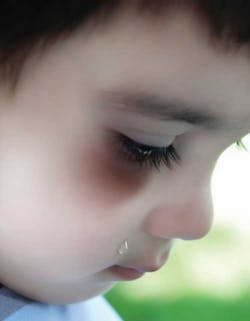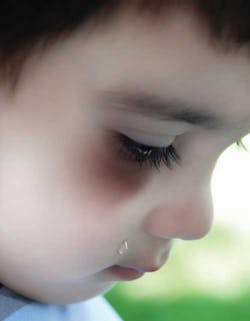Saving a life
Recognizing the signs of human trafficking, abuse, and neglect
by Linda Blackiston, RDH, BS
You may have the ability to save someone's life today. Most dental professionals probably never think about that as they enter their offices. However, there is more to treating patients than recognizing their oral diseases; recognizing the signs of human trafficking, abuse, and neglect in children and adults may offer victims an escape from a dangerous situation.
Human trafficking
"Human trafficking is a modern-day form of slavery. Victims of human trafficking are subjected to force, fraud, or coercion, for the purpose of sexual exploitation or forced labor. Victims are young children, teenagers, men, and women. After drug dealing, human trafficking is tied with the illegal arms industry as the second largest criminal industry in the world today, and it is the fastest growing."1 The U.S Department of State estimates that approximately 600,000 to 800,000 victims are trafficked internationally annually. Many victims are brought into the United States from Asia, Central and South America, and Eastern Europe. Most of the victims do not speak or understand English. "Many victims of trafficking are exploited for purposes of commercial sex, including prostitution, stripping, pornography, and live-sex shows. However, trafficking also takes place as labor exploitation, such as domestic servitude, sweatshop factories, or migrant agricultural work. Traffickers use force, fraud, and coercion to compel women, men, and children to engage in these activities."2
"Look Beneath the Surface" is part of the "Rescue and Restore" campaign on human trafficking sponsored by the U.S. Department of Health and Human Services. This campaign's intent is to increase the number of identified trafficking victims and to help those victims recover their lives and to live safely in the United States. One phase of the campaign begins by educating individuals who may encounter victims but may not recognize them. A goal of "Rescue and Restore" is to educate the health-care community to "look beneath the surface" and ask the right questions to recognize that an individual needs help.
Recognizing the signs
Recognizing the signs that someone has been trafficked could save their life. Some of the clues to look for include:
Malnutrition, dehydration, or poor personal hygiene
Sexually transmitted diseases
Signs of abuse
- Bruising, broken bones, or other signs of untreated medical problems
- Does not hold his/her own identity or travel documents
- Is reluctant to speak, always has a "translator" present
- The "translator" is more concerned about appearance than health (especially in sex trafficking)
- The "translator" offers to pay for all the dental work with cash
- The "translator" will not leave the victim alone with anyone
- Someone else controls all the money; victim will have very little or no pocket money3
If you suspect you may have had contact with someone that is a victim of human trafficking, call the National Human Trafficking Resource Center at (888) 373-7888. This hotline is set up to help people determine if they have had contact with a victim. It will also help to locate local resources in the community. For more information on human trafficking, visit www.acf.hhs.gov/trafficking.
Abuse and neglect
It is estimated that in 2007 5.8 million children were involved in 3.2 million child abuse reports and allegations. A report of child abuse is made every 10 seconds. Almost five children die every day as a result of child abuse. More than three out of four are under the age of 4. Child abuse occurs at every socioeconomic level, across ethnic and cultural lines, within all religions and at all levels of education.4
P.A.N.D.A. (Prevent Abuse and Neglect through Dental Awareness) is a program that was founded in Missouri by Dr. Lynn Mouden. The purpose of the program is to train dental professionals and other health-care providers on recognizing and responding to cases of abuse and neglect in patients.
Many dental professionals tend to deal with abuse and neglect with an attitude of "it doesn't happen in my community or dental practice." Dentists and dental hygienists are mandated reporters of suspected child abuse and neglect cases in all 50 states. The report should be made to social service or law enforcement agencies. In order to report suspected abuse, it needs to be recognized. Most physicians receive minimal training when it comes to oral health or the oral cavity; therefore, they may not notice the oral aspects of abuse or neglect. Dental offices may want to consider collaborating with local physicians to increase the detection and prevention of this tragic event.5 Child abuse and neglect are defined by federal and state laws. The Federal Child Abuse Prevention and Treatment Act (CAPTA) provides minimum standards that states must incorporate in their statutory definitions of child abuse and neglect. The CAPTA definition of child abuse and neglect, at a minimum, refers to: "Any recent act or failure to act on the part of a parent or caretaker which results in death, serious physical or emotional harm, sexual abuse, or exploitation, or an act or failure to act which presents an imminent risk of serious harm."6 Every state provides definitions of child abuse and neglect in its statutes.
Signs of abuse
Most signs of abuse occur in the head and neck area,7 so the dental community is well-suited to recognize them. Recognizing abuse or neglect is the first step; reporting it is the next step. Most abusers will not return to the same physician, but they will typically continue care with a dental practice. Dental professionals may observe a few of the indicators that a child may be suffering abuse, such as chipped or cracked teeth, bruises around the ears, finger marks on the neck, and/or a black eye or bruises in different stages of healing. The presence of one of these does not definitively prove abuse is occurring. However, any of them occurring repeatedly or in combination may warrant further investigation. Research seems to indicate that dental professionals are the least likely of all health-care providers to report abuse. It has been shown that the issue of education for health-care providers is particularly important, because it increases the rates at which clinicians report suspected abuse. The overall findings of research show in general that all health-care professionals have low rates of reporting, whereas clinicians with more education on the matter suspect abuse more often.8
Some of the barriers to reporting or to intervention are:
- Limited knowledge of family violence issues
- Lack of practical experience on how to intervene
- Misconceptions about the nature of intervention
- Fear of litigation
- Lack of local referral information
- The presence of a parent
- Concern about offending patients
- Embarrassment about bringing up the topic9,10
If you believe you are treating a child who is being or has been abused, call the local authorities or (800) 4-A-CHILD, or (800) 422-4453, and then press 1 to talk to a hotline counselor. The counselor will help you decide on a course of action, prepare you for what to expect when reporting abuse, and provide the number of the local reporting agency.
Education
Education seems to be the key to increasing the rate for recognizing and reporting suspected cases of abuse, whether it is human trafficking or child abuse. Maryland, along with some other states, now requires that dentists and hygienists take a course on recognizing abuse. Mid-Atlantic P.A.N.D.A. has partnered with Philips Sonicare. Philips offers two successive, free one-hour continuing-education courses online to educate the dental community. (Visit www.sonicare.com/dp and click on CE webinars; Philips is an approved AGD/PACE Program Provider.) The webinars include information on recognizing child, spouse, and elder abuse along with education on recognizing human trafficking. The combination of the two courses will satisfy the continuing-education requirement for this topic in many states. Even if you are not required to take the course for licensure, the education received may help you save someone's life. The intent of this article is not to completely educate dental professionals on the signs of abuse and neglect; rather, it is meant as an encouragement to seek out education on the subject. Take the next step in patient care and "Look Beneath the Surface."
Linda Blackiston, RDH, BS, received her Bachelor of Science in Dental Hygiene from Baltimore College of Dental Surgery, Dental School, University of Maryland after she had been a business owner for nine years. Her professional and clinical background includes corporate pharmaceuticals, general practice, periodontics, and a staff position in pediatric dentistry at the University of Maryland. Linda has a passion for volunteering and has served underprivileged areas in the United States and Mexico. She works with Mid Atlantic PANDA (Prevent Abuse and Neglect Through Dental Awareness) providing free continuing education courses. Linda serves on The Samaritan Women board of directors (www.thesamaritanwomen.org); an organization dedicated to serving women who are rebuilding their lives from hurtful choices and difficult life circumstances. Linda is currently manager of Professional Education in the mid-Atlantic for Philips/Sonicare. She writes and lectures nationally on women's health issues, pediatric dentistry, teenage issues, patient compliance, and biofilms. She continues to practice dental hygiene part-time in the Baltimore area.
References
1. U.S. Department of Health and Human Services, fact sheet available at http://www.acf.hhs.gov/trafficking/about/fact_human.html. Accessed Aug. 10, 2010.
2. U.S. Department of Health and Human Services, fact sheet available at http://www.acf.hhs.gov/trafficking/about/fact_human.html. Accessed Aug. 10, 2010.
3. Human trafficking.org, a web resource for combating human trafficking available at http://www.humantrafficking.org/combat_trafficking. Accessed Aug. 10, 2010.
4. Childhelp available at http://www.childhelp.org/pages/statistics. Accessed Aug. 10, 2010.
5. American Academy of Pediatrics Committee on Child Abuse and Neglect; American Academy of Pediatric Dentistry; American Academy of Pediatric Dentistry Council on Clinical Affairs. Guideline on oral and dental aspects of child abuse and neglect. Pediatr Dent. 2008-2009; 30(Suppl):86-89.
6. U.S. Department of Health and Human Services, Administration for Children and Families. Definitions of child abuse and neglect. Available at http://www.childwelfare.gov/systemwide/laws_policies/statutes/define.cfm. Accessed Aug. 10, 2010.
7. Mouden LD, Bross DC. Legal issues affecting dentistry's role in preventing child abuse and neglect. J Am Dent Assoc 1995; 126:1173-80.
8. Tilden VP, Schmidt TA, Limandri BJ, Chiodo GT, Garland MJ, Loveless PA. Factors that influence clinicians' assessment and management of family violence. Am J Public Health. April 1994; 84(4): 628-633.
9. Littel K. Family Violence: An Intervention Model for Dental Professionals Report from U.S. Department of Justice Office of Justice Programs Office for Victims of Crime. Dec. 2004.
10. U.S. Department of Health and Human Services "Recognizing Child Abuse and Neglect: Signs and Symptoms" available at http://www.childwelfare.gov/pubs/factsheets/signs.cfm. Accessed Aug. 10, 2010.
Past RDH Issues

